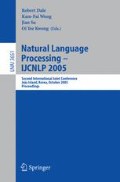Abstract
In this paper, a resolution system is presented to tackle nominal and pronominal anaphora in biomedical literature by using rich set of syntactic and semantic features. Unlike previous researches, the verification of semantic association between anaphors and their antecedents is facilitated by exploiting more outer resources, including UMLS, WordNet, GENIA Corpus 3.02p and PubMed. Moreover, the resolution is implemented with a genetic algorithm on its feature selection. Experimental results on different biomedical corpora showed that such approach could achieve promising results on resolving the two common types of anaphora.
Access this chapter
Tax calculation will be finalised at checkout
Purchases are for personal use only
Preview
Unable to display preview. Download preview PDF.
References
Baldwin, B.: CogNIAC: high precision coreference with limited knowledge and linguistic resources. In: Proceedings of the ACL 1997/EACL 1997 workshop on Operational factors in practical, robust anaphora resolution, pp. 38–45 (1997)
Castaño, J., Zhang, J., Pustejovsky, H.: Anaphora Resolution in Biomedical Literature. In: International Symposium on Reference Resolution (2002)
Dagan, I., Itai, A.: Automatic processing of large corpora for the resolution of anaphora references. In: Proceedings of the 13th International Conference on Computational Linguistics (COLING 1990), vol. III, pp. 1–3 (1990)
Denber, M.: Automatic resolution of anaphora in English. Technical report, Eastman Kodak Co. (1998)
Gaizauskas, R., Demetriou, G., Artymiuk, P.J., Willett, P.: Protein Structures and Information Extraction from Biological Texts: The PASTA System. Bioinformatics (2003)
Gasperin, C., Vieira, R.: Using word similarity lists for resolving indirect anaphora. In: ACL Workshop on Reference Resolution and its Applications, Barcelona (2004)
Grosz, B.J., Joshi, A.K., Weinstein, S.: Centering: A framework for modelling the local coherence of discourse. Computational Linguistics, 203–225 (1995)
Hahn, U., Romacker, M.: Creating Knowledge Repositories from Biomedical Reports:The MEDSYNDIKATE Text Mining System. In: Pacific Symposium on Biocomputing (2002)
Hobbs, J.: Pronoun resolution, Research Report 76-1. Department of Computer Science, City College, City University of New York (August 1976)
Kennedy, C., Boguraev, B.: Anaphora for everyone: Pronominal anaphora resolution without a parser. In: Proceedings of the 16th International Conference on Computational Linguistics, pp. 113–118 (1996)
Kim, J., Jong, C.P.: BioAR: Anaphora Resolution for Relating Protein Names to Proteome Database Entries. In: ACL Workshop on Reference Resolution and its Applications, Barcelona Spain, pp. 79–86 (2004)
Liang, T., Wu, D.S.: Automatic Pronominal Anaphora Resolution in English Texts. Computational Linguistics and Chinese Language Processing 9(1), 21–40 (2004)
Mitkov, R.: Robust pronoun resolution with limited knowledge. In: Proceedings of the 18th International Conference on Computational Linguistics (COLING 1998)/ACL 1998 Conference Montreal Canada, pp. 869–875 (1998)
Mitkov, R.: Anaphora Resolution: The State of the Art. In: Working paper Based on the COLING 1998/ACL 1998 tutorial on anaphora resolution (1999)
Mitkov, R., Evans, R., Orasan, C.: A new fully automatic version of Mitkov’s knowledge-poor pronoun resolution method. In: Proceedings of CICLing- 2000 Mexico City Mexico (2002)
Modjeska, N., Markert, K., Nissim, M.: Using the Web in Machine Learning for Other-Anaphora Resolution. In: Proceedings of the Conference on Empirical Methods in Natural Language Processing (EMNLP 2003), Sapporo Japan (2003)
Navarretta, C.: An Algorithm for Resolving Individual and Abstract Anaphora in Danish Texts and Dialogues. In: ACL Workshop on Reference Resolution and its Applications Barcelona, Spain, pp. 95–102 (2004)
Ng, V., Cardie, C.: Improving Machine Learning Approaches to Coreference Resolution. In: Proceedings of the 40th Annual Meeting of the Association for Computational Linguistics, Association for Computational Linguistics (2002)
Oh, I.S., Lee, J.S., Moon, B.R.: Hybrid Genetic Algorithms for Feature Selection. IEEE Transactions on pattern analysis and machine 26(11) (2004)
Ohta, T., Tateisi, Y., Kim, J.D., Lee, S.Z., Tsujii, J.: GENIA corpus: A Semantically Annotated Corpus in Molecular Biology Domain. In: Proceedings of the ninth International Conference on Intelligent Systems for Molecular Biology (ISMB 2001) poster session, p. 68 (2001)
Pustejovsky, J., Rumshisky, A., Castaño, J.: Rerendering Semantic Ontologies: Automatic Extensions to UMLS through Corpus Analytics. In: LREC 2002 Workshop on Ontologies and Lexical Knowledge Bases (2002)
Siddharthan, A.: Resolving Pronouns Robustly: Plumbing the Depths of Shallowness. In: Proceedings of the Workshop on Computational Treatments of Anaphora, 11th Conference of the European Chapter of the Association for Computational Linguistics (EACL 2003), pp. 7–14 (2003)
Yang, X., Su, J., Zhou, G., Tan, C.L.: Improving Pronoun Resolution by Incorporating Coreferential Information of Candidates. In: Proceedings of ACL 2004, pp. 127–134 (2004)
Author information
Authors and Affiliations
Editor information
Editors and Affiliations
Rights and permissions
Copyright information
© 2005 Springer-Verlag Berlin Heidelberg
About this paper
Cite this paper
Liang, T., Lin, YH. (2005). Anaphora Resolution for Biomedical Literature by Exploiting Multiple Resources. In: Dale, R., Wong, KF., Su, J., Kwong, O.Y. (eds) Natural Language Processing – IJCNLP 2005. IJCNLP 2005. Lecture Notes in Computer Science(), vol 3651. Springer, Berlin, Heidelberg. https://doi.org/10.1007/11562214_65
Download citation
DOI: https://doi.org/10.1007/11562214_65
Publisher Name: Springer, Berlin, Heidelberg
Print ISBN: 978-3-540-29172-5
Online ISBN: 978-3-540-31724-1
eBook Packages: Computer ScienceComputer Science (R0)

